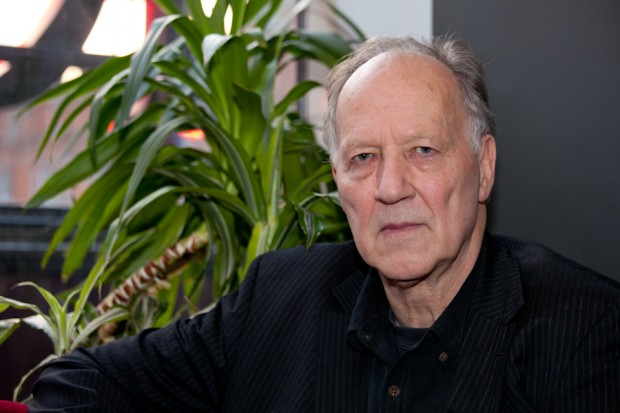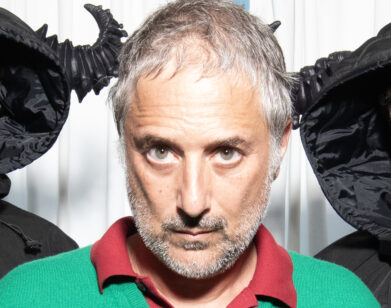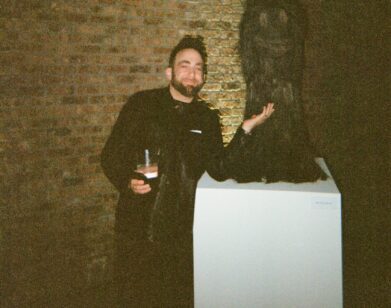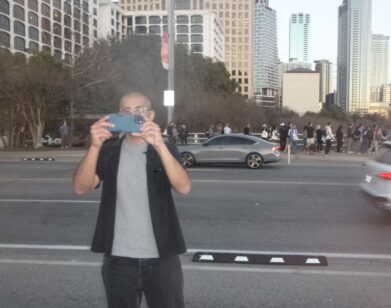Werner Herzog’s Abyss Stares Back

WERNER HERZOG
Werner Herzog, director of more than 60 features and documentaries, has dragged a ship over an Amazonian hillside in Fitzcarraldo, been nominated for an Oscar with Enounters at the End of the World, and brought ancient cave drawing to pulsing, ecstatic life with 3-D cameras in Cave of Forgotten Dreams. Chronicling a triple homicide in Texas and its legal and emotional ramifications, his most recent film, Into the Abyss, probes the murky center of the death-penalty debate. Achieving what he describes as “a gaze into the abyss of the human soul,” Herzog explores murder—both criminal and state-sanctioned—and asks the viewer to reach their own conclusions about death and the tenacity of life.
LEAH CARROLL: How are you?
WERNER HERZOG: It is difficult being German, you know, but I am getting by!
CARROLL: When I heard Into the Abyss would be your next project, I was intrigued, partly as the daughter of a murdered mother and as someone who is personally quite conflicted about the death penalty. I wondered, “What will his take on this be?”
HERZOG: Well, in many ways, the film is actually for the families of violent crime. It is dedicated to them. And movies hardly ever speak about that side. There is a fascination about crime, which is understandable, but hardly anyone talks about the families of victims of violent crime and the devastation that is beyond the victim alone.
CARROLL: Along those lines, I thought the portrayal of the families of the killers was very interesting. Jason Burkett’s father, in particular, was a very poignant character. Is that balance between the families of the victims and the families of the perpetrators something that came together organically, or did you seek that story out?
HERZOG: [Delbert Burkett, Jason’s father] was very tragic. I was fascinated by him, because he was the person who apparently saved his son from execution. Because of that I really wanted to talk to him, but how tragic a figure he was, I had no idea. You see, every single person in the film, I’ve met less than one hour in my entire life. With one exception—Melissa Burkett, the wife of Jason Burkett. I met her once before shooting at a dinner. She wanted to feel out what we were doing and assess the situation, and of course I would allow her to do that.
CARROLL: So each interview was only an hour long?
HERZOG: Sometimes less—the death row chaplain, for instance, was only 25 minutes. He came in quick, quick, quick, saying, “I have to be in the death house in 40 minutes.” Or for example, Jared Talbert, probably not more than 20 or 30 minutes in my entire life.
CARROLL: And what was behind the decision to bookend the film with the prison chaplain and the former executioner?
HERZOG: It just came together organically. You see, I am a filmmaker, a storyteller, and it was almost instantly obvious that the chaplain should be like a prologue because what emerges out of all this material is not just death. It is life—the urgency of life—and this is why the title of the film is Into the Abyss and then there is a smaller title: “A tale of death, a tale of life.” I had no plan to make a film about the urgency of life, but all of the sudden it presents itself. It was just there. And you just couldn’t bypass it anymore.
CARROLL: What was the original plan?
HERZOG: Well, the plan—it was not so much of a plan, but a story of a senseless crime and all its ramifications. A true American Gothic, in a way. But it happens sometimes that the material itself carries things you have not fully planned. The footage has its own right, its own life, its own vibrancy and energy in it. The urgency of life becomes the subject of the film.
CARROLL: How did you find this particular crime?
HERZOG: I looked at death row inmates, in many states, but Texas happens to be very media-friendly. They are so convinced about criminal justice there that they make it very transparent. I looked at some other cases in Texas, and one case in Florida. In some other states I was not allowed in. And then I was looking at cases where I had the feeling it was not just an average crime like, let’s say, a violent bank robbery where the guard in the bank or the bank teller won’t hand over the cash and they are shot. In that kind of crime there is a certain aim, a certain plan. And in this case, what drew my attention was the amount of senselessness. And I knew it would have real ramifications in all directions.
CARROLL: Did you have a sense while you were interviewing—
HERZOG: I am not interviewing anyone. I do not have the attitude of a journalist. I approach it as a filmmaker. It is a discourse, a conversation. I am sorry to interrupt.
CARROLL: So, in these conversations, was there any sense to you, given the utter senselessness of the crime, that it could have been any of the boys you spoke with—not just the ones who actually did the crime—but that it could have been any one of them who wound up becoming a killer? For instance, could it just as easily have been perpetrated by someone like Jared Talbert, who speaks to you about his violent past, in place of Jason Burkett and Michael Perry?
HERZOG: No! I vehemently disagree. Jared Talbert’s story is different. In a fight, he gets stabbed with a 20-inch screwdriver through his thorax and actually survives it. A friend throws him a knife and he sees it at his feet and decides he is not going to pick it up because he wants to see his children at night. He was under life-threatening attack and he decides not to pick up the weapon. He is a contrast to the perpetrators. He’s actually a true hero. He should get a medal of honor for that.
CARROLL: So is he an example of the penal system working correctly?
HERZOG: He is the good side of the penal system. He comes out and he is not illiterate anymore. And you can tell how much I like him and how much I liked my discourse with him. With Perry, for instance, within 120 seconds I tell him that life didn’t dish out a real good deck of cards but it does not exonerate him and it does not necessarily mean that I have to like him. You see the conversation could have been over within two minutes, because I am speaking very openly with him. But he really liked that I was so candid. They all liked that I was so straightforward. They all want me back.
CARROLL: Did you like Perry?
HERZOG: I can’t really make a judgment. I have been in lots of very intense life situations. I have been shot at, and I have been hungry, and I have been in solitude, and I have also briefly been behind bars. So in a way, I know the heart of men. But of all the death row inmates I have seen, he, according to my knowledge of the human heart, was the most dangerous of them all. He would be the last of all of them I would like to meet in a murky situation in a dark alley. And he looks very boyish, like a lost kid. He looks like someone who would be good together in a film with James Dean. This kind of boyish, lost, kid. But in my opinion I’ve never seen anyone so dangerous. And when he speaks with me, he seems to be completely oblivious that he is on death row and will be killed in eight days and instead he speaks about a canoe expedition in the Everglades and alligators.
CARROLL: Do you think the film would be quite different if he hadn’t been executed?
HERZOG: No. I don’t think so. But of course it gives the film some gravitas.
CARROLL: Where do you see Into the Abyss along the lines of films like The Thin Blue Line, or Paradise Lost or other films where there is social justice component?
HERZOG: Well, they have a different agenda. They are issue films, and their issue is trying to prove the innocence of an inmate. This is totally legitimate, but my film is not an issue film, and I told every inmate in writing and then later when I met them, “This film is not going to serve as a platform to prove your innocence.” Besides, no film in the world could have proven their innocence. It’s just not in the story of these two perpetrators. Although I allow them, for a moment, to maintain their innocence. So I don’t mind.
CARROLL: There is no voiceover in this film. Why did you make that choice?
HERZOG: Each film and each subject forces its own form. In this film, it would have been silly to comment. It has to play itself out as it is. There are certain element we included, like captions, to explain things like “this is police video” and things like that.
CARROLL: Did you write the captions?
HERZOG: Yes.
CARROLL: So, being German, what do you think the death penalty says about America?
HERZOG: What does it say about China? What does it say about Iran? What does it say about Pakistan? Russia, by the way, just gave it up. What does it say about Japan and many other countries? You shouldn’t think America is exclusive and has invented it.
CARROLL: But do you find those other countries to be a sort of peculiar company for America?
HERZOG: Well, you are probably talking about the idea of American exceptionalism. Of course America in a way has exceptional achievements like separation of powers, which is an enormous achievement of civilization. But… I’m sorry. I lost your question…
CARROLL: I guess I’m asking, that when you refer to the film as an American Gothic, do you therefore view it also as a uniquely American story?
HERZOG: I mean Gothic in terms of a senseless crime. The punishment itself is something I respectfully disagree with, but for thousands and thousands of years it was practiced everywhere. There is a transition, but it takes centuries. Germany was particularly bad in my opinion and of course has a different historical background—genocide, euthanasia, excessive use of capital punishment. I think a state should not be in the capacity of killing anyone with the exception of warfare. But that is another chapter.
CARROLL: And what do you do next?
HERZOG: Well, I’m finishing four films for television on death-row inmates. Then I’m acting in a Hollywood film. Then I do my Rogue Film School. And things like that.
INTO THE ABYSS IS OUT IN LIMITED RELEASE TOMORROW.






